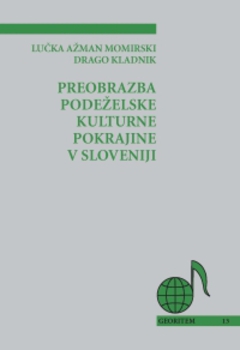Preobrazba podeželske kulturne pokrajine v Sloveniji
The book offers multi-layered responses to the scope and causes of spatial, as well as social, economic and physiognomic changes in the cultural landscape in Slovenian countryside. It presents the results of an interdisciplinary research approach to recognising spatial change and trends within a two-year research project entitled "The Transformation of the Landscape by Agricultural Modernisation and Changes in Settlement Patterns", which was financed by the Slovenian Research Agency and the Ministry of the Environment and Spatial Planning of the Republic of Slovenia within the target research programme Slovenian Competitiveness 2006–2013. Similar research was carried out in three pilot areas, selected because they captured a cross section of typical Slovenian landscape macro-units (Mediterranean, Dinaric, Alpine and Pannonian), while also covering the processes of intensification and marginalisation. The cadastral communities of Žalec and Gotovlje within the Žalec municipality offer an example of intensification; the two are in contact with both the Alpine and the Pannonian regions. The cadastral community of Kožbana in the municipality of Brda, as a representative of the Mediterranean region, and the cadastral community of Sela pri Hinjah in the municipality of Žužemberk, representing the Dinaric region, were selected to illustrate marginalisation. The geographical outline includes a general description of each area, placing it within its wider landscape unit, with data on rock, surface features, and waters, climate, soils and vegetation, population and settlements. This is supplemented with an outline of the landscape form and agriculture and its recent historical development. Thematic maps of settlement patterns are produced at the cadastral community and individual settlement levels. The state of selected farms in pilot areas is also described and reasons for their expansion given. Land use reveals changes in agricultural methods, land abandonment, forest re-growth, the expansion of urbanisation and industrialisation and similar. Landscape regionalisation and typing of the selected areas is a development and supplementation of existing regional divisions by landscape type in Slovenia. The conclusion of the work presents three spatial development scenarios, proposed general and specific guidelines for settlement expansion and policies to protect and manage individual agricultural units at the local level. In the case of the Kožbana cadastral community the local issue of potential landslides is studied, while in another two pilot areas the spatial and function changes in settled land are studied. Some general problems are defined which arise in the projecting of new buildings and spatial plans for rural areas, and evaluating landscape changes in terms of the settlement system and in terms of the evaluation and policy-making to protect and manage individual features of landscape value. The book also sets out a series of proposed instruments to direct spatial development.
Downloads

Series
License

This work is licensed under a Creative Commons Attribution-NonCommercial-NoDerivatives 4.0 International License.
